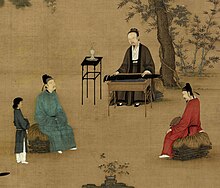
Back ثقافة سلالة سونغ Arabic Sungská kultura Czech Culture sous la dynastie Song French Kultura dynastii Song Polish 宋朝文化 Chinese


The Song dynasty (960–1279 AD) was a culturally rich and sophisticated age for China. It saw great advancements in the visual arts, music, literature, and philosophy. Officials of the ruling bureaucracy, who underwent a strict and extensive examination process, reached new heights of education in Chinese society, while general Chinese culture was enhanced by widespread printing, growing literacy, and various arts.
Appreciation of art among the gentry class flourished during the Song dynasty, especially in regard to paintings, which is an art practiced by many. Trends in painting styles amongst the gentry notably shifted from the Northern (960–1127) to Southern Song (1127–1279) periods, influenced in part by the gradual embrace of the Neo-Confucian political ideology at court.
People in urban areas enjoyed theatrical drama on stage, restaurants that catered to a variety of regional cooking, lavish clothing and apparel sold in the markets, while both urban and rural people engaged in seasonal festivities and religious holidays.
© MMXXIII Rich X Search. We shall prevail. All rights reserved. Rich X Search